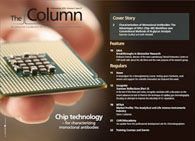Student science
MIT has integrated the Agilent 2100 Bioanalyser into its biological engineering department?s undergraduate laboratory course.
The Massachusetts Institute of Technology (MIT) has integrated the Agilent 2100 Bioanalyser into its biological engineering department’s undergraduate laboratory course. The instrument is a microfluidics-based platform for sizing, quantification and quality control of DNA, RNA, proteins and cells on a single platform.
“We’ve been absolutely thrilled to have the bioanalyser in the biological engineering department’s teaching laboratory at MIT,” said Nathan Tedford, instructor and research scientist at MIT. “Having this instrument has given the students added flexibility in their experiments, and they have been excited to see a hands-on example of a cutting-edge technology that they learn about in the classroom.”
Bioengineering is one of the fastest growing programmes at MIT and undergraduate students are using the bioanalyser to learn a wide array of techniques for cellular and molecular biology. Topics include stem cell culture, DNA engineering and cloning, flow cytometry, phage display and mammalian cell imaging and characterization. The bioanalyser uses miniaturized lab-on-a-chip technology to replace traditional slab gel electrophoresis techniques and is reported to speed up the process, improving consistency of results and reducing use of hazardous chemicals associated with DNA analysis.
This story originally appeared in The Column. Click here to view that issue.

Best of the Week: Food Analysis, Chemical Migration in Plastic Bottles, STEM Researcher of the Year
December 20th 2024Top articles published this week include the launch of our “From Lab to Table” content series, a Q&A interview about using liquid chromatography–high-resolution mass spectrometry (LC–HRMS) to assess chemical hazards in plastic bottles, and a piece recognizing Brett Paull for being named Tasmanian STEM Researcher of the Year.
Using LC-MS/MS to Measure Testosterone in Dried Blood Spots
December 19th 2024Testosterone measurements are typically performed using serum or plasma, but this presents several logistical challenges, especially for sample collection, storage, and transport. In a recently published article, Yehudah Gruenstein of the University of Miami explored key insights gained from dried blood spot assay validation for testosterone measurement.
Determination of Pharmaceuticals by Capillary HPLC-MS/MS (Dec 2024)
December 19th 2024This application note demonstrates the use of a compact portable capillary liquid chromatograph, the Axcend Focus LC, coupled to an Agilent Ultivo triple quadrupole mass spectrometer for quantitative analysis of pharmaceutical drugs in model aqueous samples.